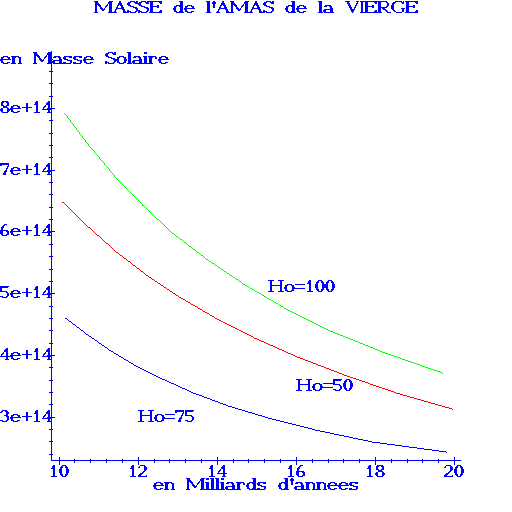Missing mass?

The various problems of missing mass are summarized
by means of the following traditional table which gives the order of magnitude of
the Omega parameter of density according to the scale of
the observations.
Omega-luminous ~ 0.01 associated to the visible matter,
Omega-galaxy ~ 0.1 associated to the dynamics of the galaxies,
Omega-cluster ~ 0.2 to 0.3 associated to the dynamics
of the clusters,
Omega-lss ~ 0.8 +/- 0.5 associated to the large scale
structures.
Finally much of cosmologists would believe (for very diverse reasons)
that Omega = Omega-universe is exactly equal to 1!

There is no question to solve all these problems of missing mass,
coming from the differences between the " Omega observed ", but
to well explain them.
1 A the scale of the universe the problem of
the determination of Omega = Omega-universe according to Ho and
of the age of the universe, arises in a very different way according to
the models, cf. the first
figure
In the standard model,
so that the universe
is older than the oldest globular clusters, it is necessary that not
only Ho is smaller than 60 km/s/Mpc, but still that Omega is
small, in fact Omega < = 0.1.
In the model of De Sitter on the other hand the age of the universe
increases with Omega. In fact the only constraint which one has so
that the universe is older than the oldest objects, is a lower
limit for Omega according to Ho; for example for Ho=75,
one needs Omega > = 0.5.
2 A big traditional problem of hidden mass
appears on the level of the rotation curves
for galaxies (to explain their flatness). In the light of
the method that we developed,
the phenomenon of flatness
of the curves
is very simply explained, without recourse to a possible massive halo, while
making evident why there is in fact less " hidden mass ".
3 To estimate Omega-cluster, it is usual to employ the traditional virial
theorem which makes it possible to evaluate the mass of a cluster
starting from
speeds of dispersion of the galaxies in this cluster. But this
virial theorem is based on the law of newtonian gravitation,
It would be better
to use a " postnewtonian virial theorem " and
as the postnewtonian field cancells at the radius of attraction,
the correction may be very significant.
To be more precise, the postnewtonian and Einsteinian theories
being equivalent, there exists a pure gravitational
pressure (negative), from where a concept of sphere (and radius)
of attraction of a local condensation of matter exists in an expanding
universe.
This fact was already announced by J.-M. Souriau.
Thus general relativity provides, by using this concept
of sphere of attraction, a new tool to estimate
Omega-cluster. As this sphere of attraction evolves with
the expansion and the age of the considered cluster, one can
obtain interesting estimates. By way of illustration,
here an estimate of the mass of the Virgo Cluster according to
her age, for various values of the Hubble parameter.




